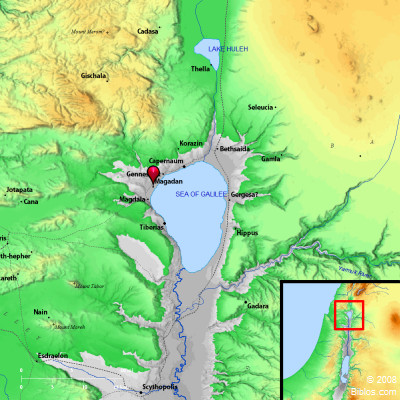Atlas  Magadan and surrounding region Maps Created using Biblemapper 3.0 Additional data from OpenBible.info Occurrences Matthew 15:39 Then he sent away the multitudes, got into the boat, and came into the borders of Magdala.Encyclopedia MAGADANmag'-a-dan, ma-ga'-dan (Magadan; the reading of the Textus Receptus of the New Testament, Magdala (the King James Version), but Magdala is unsupported): This name appears only in Matthew 15:39. In the parallel passage, Mark 8:10, its place is taken by Dalmanutha. From these two passages it is reasonable to infer that "the borders of Magadan" and "the parts of Dalmanutha" were contiguous. We may perhaps gather from the narrative that they lay on the western shore of the Sea of Galilee. After the feeding of the 4,000, Jesus and His disciples came to these parts. Thence they departed to "the other side" (Mark 8:13), arriving at Bethsaida. This is generally believed to have been Bethsaida Julias, Northeast of the sea, whence He set out on His visit to Caesarea Philippi. In this case we might look for Dalmanutha and Magadan somewhere South of the Plain of Gennesaret, at the foot of the western hills. Stanley (SP, 383) quotes Schwarz to the effect that a cave in the face of these precipitous slopes bears the name of Teliman or Talmanutha. If this is true, it points to a site for Dalmanutha near `Ain el-Fuliyeh. Magadan might then be represented by el-Mejdel, a village at the Southwest corner of the Plain of Gennesaret. It is commonly identified with Magdala, the home of Mary Magdalene, but without any evidence. The name suggests that this was the site of an old Hebrew mighdal, "tower" or "fortress." The village with its ruins is now the property of the German Roman Catholics. The land in the plain has been purchased by a colony of Jews, and is once more being brought under cultivation. MAG'DALA, now el Mejdel on the w. shore of the sea of Tiberias, now a little village. Matt. 15:39. Strong's Greek G3093: MagadanMagadan, an unidentified place near the Sea of Galilee |



